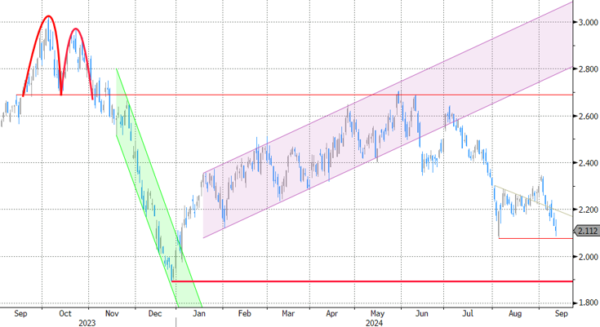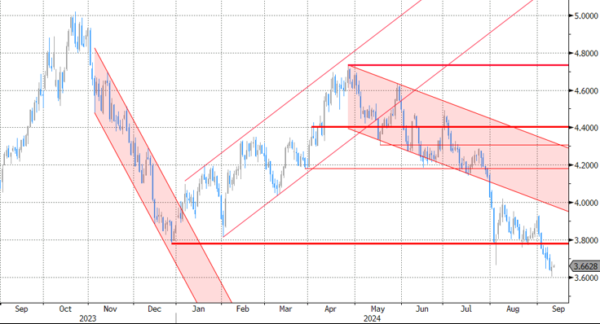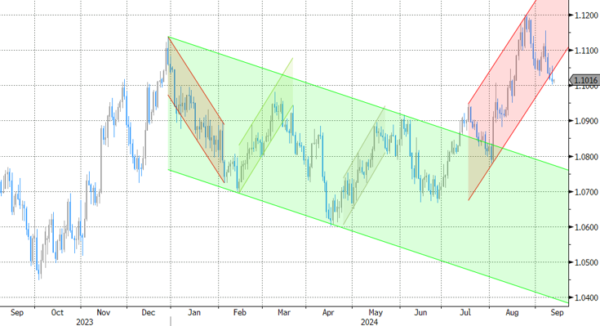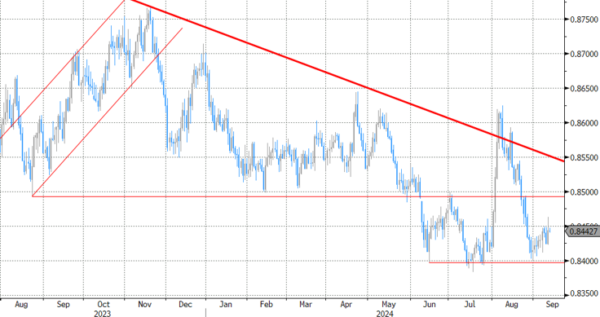Markets
US yields finished 0.3 bps (30-yr) to 4.6 bps (2-yr) higher yesterday in a volatile session. The (trade-weighted) dollar approaches first resistance at 101.92/102 (101.68 close). EUR/USD came within striking distance of the 1.10 mark. For most of US trading hours, the key question was whether a small upward surprise in monthly US core CPI (0.3% M/M instead of 0.2%) was sufficient to completely close the door on a 50 bps rate cut by the Fed next week. In the end, money markets reduced bets on such a start, but the door remains open. The upward surprise came especially from shelter costs and was for a large part compensated for by lower energy prices. Core US CPI could nevertheless remain sticky above 3% Y/Y for somewhat longer than earlier anticipated. The US Treasury’s $39bn 10-yr Note auction was strong with the auction yield 1.4 bps below the WI yield. The bid-cover (2.64) was also above the 6-month average (2.53). An AI-driven rally pulled US stock markets up to 2.17% higher for the Nasdaq.
The ECB is expected to cut its deposit rate for a second time this year by 25 bps, to 3.50%. As announced in March, they will also reduce the spread between the main refinancing rate and the deposit rate from the current 50 bps to only 15 bps implying an MRR rate cut of 60 bps, from 4.25% to 3.65%. Updated GDP and CPI forecasts will be closely watched for clues on the monetary policy trajectory going forward. However, we don’t expect big changes apart from perhaps some minor downward revisions to this year’s GDP and headline CPI data. Recall that ECB staff in June plotted a 0.9%-1.4%-1.6% growth path for 2024-2026 and a 2.5%-2.2%-1.9% inflation trajectory. While keeping an easing bias, we don’t expect the central bank to pre-commit to specific actions at coming meetings. The short intermeeting period between September 12 and October 17 suggests that bar any big surprise, the central bank might be more inclined to sit the October meeting out and stick with the currently, quarterly, rate-reduction scheme with a next 25 bps move coming only in December. Unlike the Fed, the ECB’s options for making policy less restrictive are smaller given limited room towards neutral territory in the current, stubborn, (core) inflationary environment. EMU money markets currently attach a 40% probability to a follow-up rate cut in October. Even if Lagarde holds back from giving any guidance for October, we believe that market speculation will remain in a context where most central banks are making their monetary policies less restrictive. This suggests that any market reaction on today’s statement and Q&A session (higher ST EUR rates and stronger EUR) could be modest and in any case temporary in nature.
News & Views
Insiders say the European Commission is examining its options to roll over several hundreds of billions of euros of EUNextGen bonds issued during the Covid-era. At the heart of the issue are the ones issued to finance the grants distributed to the member states. Unlike the loans, which have to be paid back by member states from 2031 on, the EC has no means outside the budget to repay those bonds when they start maturing. The amount of grants currently disbursed is some €170bn but could increase to as much as €357bn. Leaving the matter unaddressed would result in yearly debt repayments and interest costs of around €30bn from 2028 on – an amount that roughly equals a sixth of the EU’s current annual spending. Former ECB president Draghi in his report on European competition earlier this week warned for this looming budget squeeze given the unwillingness (for now) of EU member states to give the Commission revenue-raising powers or additional money. It was Draghi too who floated the idea of rolling over the debt. The topic is a controversial one, especially for the likes of Germany who’s constitutional court only approved the EUNextGen programme on the grounds it was a one off and time-limited. Changing the terms requires unanimous backing of all member states.
The UK Royal Institution of Chartered Surveyors (RICS) said the house price balance edged up to 1% in August, a significant jump from the -18% recorded in July (and vs consensus of -14%). It was the first positive outcome since October 2022 and has come a long way from the a post-GFC low at -64.5% exactly one year ago. All subindices posted improvements compared to July with price expectations (from 9% to 14%), sales expectations (37%) and new buyer enquiries (15%) al rising solidly. Agreed sales (6%) climbed to the highest level since May 2021.
Graphs
GE 10y yield
The ECB cut policy rates by 25 bps in June. Stubborn inflation (core, services) make follow-up moves less evident. Markets nevertheless price in two to three more cuts for 2024 as disappointing US and unconvincing EMU activity data rolled in, dragging the long end of the curve down. The move accelerated during the early August market meltdown.
US 10y yield
The Fed in its July meeting paved the way for a first cut in September. It turned attentive to risks to the both sides of its dual mandate as the economy is moving to a better in to balance. The pivot weakened the technical picture in US yields. A string of weak eco data and a risk-off market climate pushed and kept the 10-yr sub 4%. We think we could be up to three 50 bps rate cuts this year.
EUR/USD
EUR/USD moved above the 1.09 resistance area as the dollar lost interest rate support at stealth pace. US recession risks and bets on fast and large rate cuts trumped traditional safe haven flows into USD. EUR/USD 1.1276 (2023 top) serves as next technical references.
EUR/GBP
The BoE delivered a hawkish cut in August. Policy restrictiveness will be further unwound gradually on a pace determined by a broad range of data. The strategy similar to the ECB’s balances out EUR/GBP in a monetary perspective. Recent better UK activity data and a cautious assessment of BoE’s Bailey at Jackson Hole are pushing EUR/GBP lower in the 0.84/0.086 range.
















